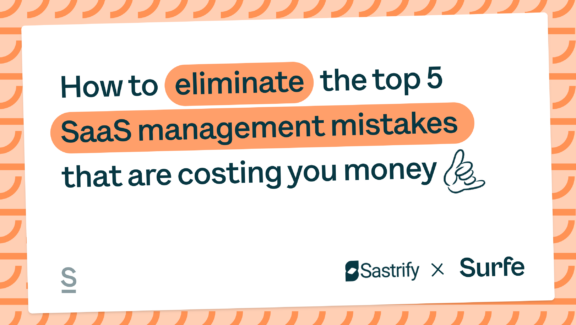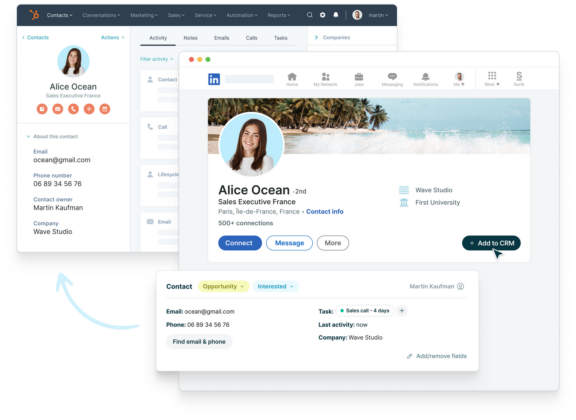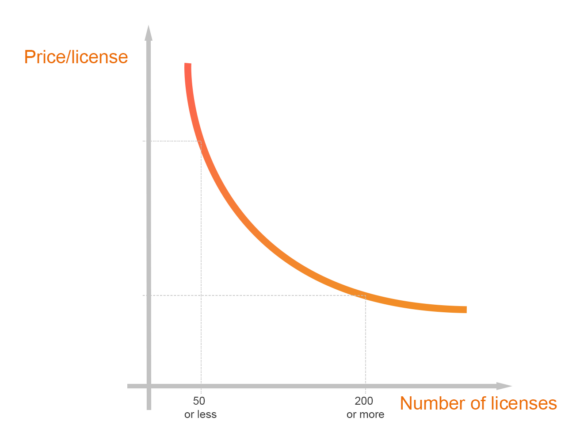How to eliminate the top 5 SaaS management mistakes that are costing you money

For those looking to reduce their SaaS management spend, here are 5 things to keep in mind…
If you’re a fellow SaaS enthusiast, try counting the number of applications that you use on a daily basis. If that was too simple, try to identify which features you use religiously, and which you haven’t touched in months – for each product.
Naturally, the more you have in your SaaS inventory, the harder it becomes.
Now imagine doing this for everyone on your team, and you will start to understand the pain that managers deal with when accounting for all of the different tools, licenses, and subscriptions that an organization is using.
Hundreds of thousands of dollars are wasted every year on dormant subscriptions, unused features, and duplicate licenses, so we’re going to break down the five most important steps you can take to eliminate mindless spending.
SaaS spend management and SaaS sprawl
According to a Gartner research report, more than 30% of SaaS fees paid by organizations are wasted on features, subscriptions, and licenses that are not being used to their full potential.
In other words, nearly a third of the average company’s SaaS spend could be allocated towards more productive business activities.
Especially for teams that are composed of multiple departments or spread across different countries and time zones, SaaS management can easily become a daunting task that is seemingly impossible to gauge. Add multiple tools into your SaaS inventory, and you will soon find yourself in the midst of a SaaS sprawl which occurs when administrators lose track of the number of third-party integrations being used on a certain network.
Top 5 SaaS management mistakes (and solutions)
1. Centralize your SaaS spending
While accounting for SaaS inventory used to be as simple as a spreadsheet overseen by the IT department, fast growing teams and remote work trends have drastically shifted the landscape in terms of onboarding and off-boarding for SaaS tools.
Being out of the office, employees have more leverage to experiment on their own terms and add tools to their stack without necessarily going through the administrative approval process. Furthermore, individual teams require different tool stacks to carry out their day to day operations, making it difficult for departments to coordinate on registration and cancellation processes, especially in large companies.
Think of how many times you’ve tried a tool but then realized it didn’t suit you.
You’d be surprised to see how many people hold on to subscriptions that don’t fulfill their needs while searching for ones that do, or simply forget to go back and cancel after making a switch.
When these changes go undocumented, a SaaS sprawl is dangerously inevitable.
SaaS management is a multifaceted responsibility and we highly recommend automating the SaaS procurement process with a tool like Sastrify if you’re working with a diverse tool stack.
More specifically, Sastrify will manage all of your SaaS subscriptions, negotiate contracts with vendors to get you the best pricing plan possible, and give you recommendations about what licenses should be added or dropped.
If you’re on the administrative side of portfolio management or finances, you can thank us later.
2. Cancel abandoned licenses and duplicate subscriptions
If we had a dollar for every time we tried a new tool, forgot about the subscription, and sat on the phone with customer service for hours in a desperate attempt to get a refund, we might actually have enough money to pay for that subscription.
All jokes aside, abandoned licenses and duplicate subscriptions are two of the biggest money eaters when it comes to SaaS costs.
The first one is pretty self explanatory.
If someone leaves the company, shifts roles or teams, or no longer has the need for a tool that was unique to a specific project, their license should be terminated immediately or at least put on hold for the time being.
It’s easy to forget about subscriptions, especially if you’re not the one paying, so it’s critical to have a centralized system in place to oversee the onboarding and off-boarding processes and avoid paying for licenses that are not being used.
The second one is not so obvious, but often gets overlooked.
Sometimes, tools have features that parallel one another meaning that you could be paying for two tools that are fundamentally different but have elements that overlap.
In this case, we advise you to do some research to find out if there is an even better tool that offers all of the required features – to avoid paying for duplicates.
Take Surfe for example. Before Surfe, users were forced to conduct research manually, then copy and paste data from LinkedIn to update a CRM contact. Now, Surfe users can prospect on LinkedIn and enrich leads, update expired contacts, and edit custom fields and deal statuses without having to leave the platform – thanks to the tool’s two-way data synchronization.

There are a myriad of tools that offer one or two of these features, but with Surfe‘s all-in-one design, users only have to manage (and pay for) a single subscription.
For all of our CRM users out there, we highly encourage you to sign up for Surfe’s free, 14-day trial or book a demo to experience the magic for yourself.
3. Don’t be afraid to downgrade (or upgrade) your subscription tier
Wouldn’t it be nice if we could hand select the features that we use and build our own subscription plans for some of the SaaS tools out there?
Too often, lower level tiers lack necessary features while upper level tiers are loaded with features that the average person doesn’t need. Both of these scenarios result in money lost – whether it be investing in a low tier plan that restricts your capabilities or investing in a high tier plan that’s not being used to its fullest potential.
Keep in mind that SaaS procurement should be a fluid process.
Not everyone in the same team or department will have the same needs depending on their missions, so it’s important to collect feedback from individual users to determine if an upgrade or downgrade is necessary.
By taking the time to assess each user’s needs and invest in the corresponding tier subscription, you will maximize both productivity and ROI.
4. Identify hidden costs
Whether it’s automatic renewals or “freemiums,” many SaaS providers will go out of their way to get that extra dollar in their pocket.
Although these practices may appear to be deceiving, it’s up to consumers to stay on top of their subscription plans and act accordingly if something is expected to change.
Remember that “hidden” costs are not always hidden or deceptive.
For example, you might be paying month by month instead of committing to an annual subscription that could yield significant savings. On the other hand, you might invest in a yearly subscription and then soon discover that the tool is no longer necessary.
With that being said, make sure you know the terms and conditions of any subscription plan before typing in your credit card credentials to ensure that you won’t be paying more than you should be – before it’s too late.
5. Consider buying in bulk to leverage your negotiating power
Did you know that you can significantly reduce the cost of your SaaS spend through negotiation?
If you’re only purchasing one or two licenses, you may be out of luck – but if you’re purchasing upwards of 10 or 20 licenses, there’s a high chance that the provider will be willing to give you a discount.
After all, it’s basic equilibrium.

Source: Sastrify
Purchasing in bulk is a viable option for large teams that are using the same subscription tier, but remember that SaaS procurement is not always a “one size fits all” process.
While you may be inclined to purchase more licenses to save money, it’s still important to take each user’s individual needs into account. After all, you might be better off buying high and low tier licenses separately than high tier licenses in bulk.
It all depends on your team, your mission, and your budget.
Bottom line
SaaS management is by no means an easy task, but following these 5 pointers will put you on the right track.
As long as you use a data driven method to fuel your SaaS spend, the results will pay off over time when you see how much money you’ve saved and how much more efficient your workflow is when you’re using the right tools.
Choosing the correct plan and monitoring the ROI from every license in your portfolio might seem overwhelming, but luckily there are resources like Sastrify to take the guesswork out.
Good luck!
If you’d like Sastrify’s team of experts to assist you with your decision making process or subscription management, you can get in touch with a representative at [email protected] or visit https://www.sastrify.com/.


